ROSES
(Last updated 1/28/06)
Portland, blessed with acidic soil
and an amenable climate, was dubbed the "City of Roses"
very early in its history, thanks to its hundreds of miles of
rose-bordered streets - often planted with the "official"
Portland Rose, "Mme. Caroline Testout" (below; recently
featured on a French postage stamp)
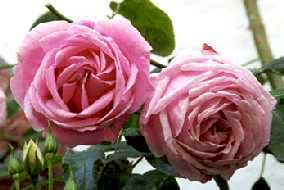 At the urging of prominent area nurserymen,
Portland's International Rose Test Garden was founded in 1917
by the Bureau of Parks in cooperation with the American Rose Society,
and has been in continuous operation ever since; it is the oldest
and largest facility of its kind in the US, containing over 500
varieties of roses on over 5 acres. The Rose Garden is located
in 41-acre Washington Park (1871), which also contains Portland's
Zoo (1887) and the 5 1/2 acre Japanese Garden (1963) within its
boundaries; these in turn, along with the 175-acre Hoyt Arboretum
and 6 other city parks, are located within the 4800 acres of Forest
Park, a "wilderness" area situated along the eastern
slope of Portland's Northwest Hills
At the urging of prominent area nurserymen,
Portland's International Rose Test Garden was founded in 1917
by the Bureau of Parks in cooperation with the American Rose Society,
and has been in continuous operation ever since; it is the oldest
and largest facility of its kind in the US, containing over 500
varieties of roses on over 5 acres. The Rose Garden is located
in 41-acre Washington Park (1871), which also contains Portland's
Zoo (1887) and the 5 1/2 acre Japanese Garden (1963) within its
boundaries; these in turn, along with the 175-acre Hoyt Arboretum
and 6 other city parks, are located within the 4800 acres of Forest
Park, a "wilderness" area situated along the eastern
slope of Portland's Northwest Hills

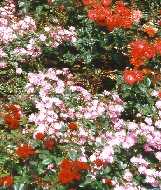
 The genus Rosa belongs to the family
Rosaceae (apples, cherries, etc), distinguished by pink or white
five-petaled blossoms; fossil remains indicate that the rose has
existed as such for at least 35 million years. Species, or wild,
roses grow throughout the Northern Hemisphere, generally in temperate
regions, and particularly in Asia and Europe, but have been identified
from the snows of North America, Siberia, and Iceland to the tropics
of Mexico, Egypt, and India, and even on the outskirts of the
Sahara. However, none have been found south of the Equator.
The genus Rosa belongs to the family
Rosaceae (apples, cherries, etc), distinguished by pink or white
five-petaled blossoms; fossil remains indicate that the rose has
existed as such for at least 35 million years. Species, or wild,
roses grow throughout the Northern Hemisphere, generally in temperate
regions, and particularly in Asia and Europe, but have been identified
from the snows of North America, Siberia, and Iceland to the tropics
of Mexico, Egypt, and India, and even on the outskirts of the
Sahara. However, none have been found south of the Equator.
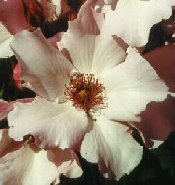
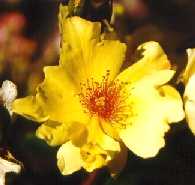
 The rose has been under cultivation
for at least 5,000 years, e.g., in China and Persia. Various ancient
civilizations revered the rose: Minoan frescoes dating from about
2800 BC contain rose decorations, wreaths of roses have been found
in Egyptian tombs and Cleopatra greeted the Romans with a carpet
of rose petals, the rose was integral to the festivals of the
classical Greeks, and the Romans used roses to garland their stadium
boxes and shower their banquet guests. After the fall of the Roman
Empire, rose cultivation was continued by Benedictine monks and
eventually became a symbol of Christianity; while, under Islam,
the rose became a symbol of perfection and was grown from Spain
to Kashmir.
The rose has been under cultivation
for at least 5,000 years, e.g., in China and Persia. Various ancient
civilizations revered the rose: Minoan frescoes dating from about
2800 BC contain rose decorations, wreaths of roses have been found
in Egyptian tombs and Cleopatra greeted the Romans with a carpet
of rose petals, the rose was integral to the festivals of the
classical Greeks, and the Romans used roses to garland their stadium
boxes and shower their banquet guests. After the fall of the Roman
Empire, rose cultivation was continued by Benedictine monks and
eventually became a symbol of Christianity; while, under Islam,
the rose became a symbol of perfection and was grown from Spain
to Kashmir.
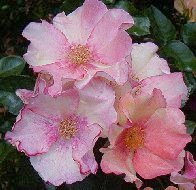
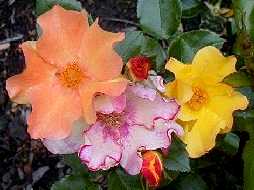 Roses are classified in a number of
different ways: by characteristics such as growth pattern (e.g.,
rambler, shrub) and flowering habit (e.g., recurrent), by their
origins (e.g., China, Bourbon), and also descriptively - by color
(using over 85 separately defined colors and color patterns),
size (e.g., Micro-mini), and type of bloom (e.g., single, double)
Roses are classified in a number of
different ways: by characteristics such as growth pattern (e.g.,
rambler, shrub) and flowering habit (e.g., recurrent), by their
origins (e.g., China, Bourbon), and also descriptively - by color
(using over 85 separately defined colors and color patterns),
size (e.g., Micro-mini), and type of bloom (e.g., single, double)
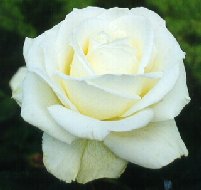
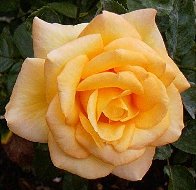
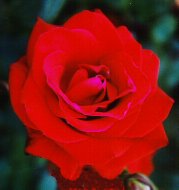 The classification proposed by the
World Federation of Rose Societies first divides rose varieties
into Old (Ancient; pre-1867) and Modern, then into Non-climbing
and Climbing
The classification proposed by the
World Federation of Rose Societies first divides rose varieties
into Old (Ancient; pre-1867) and Modern, then into Non-climbing
and Climbing
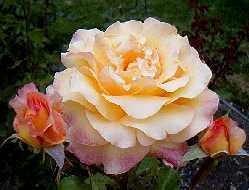 The Modern Roses are then further divided
into Non-recurrent and Recurrent, then again into Ramblers, Climbers,
and Miniatures for the former, Shrub, Ground Cover, and Bush for
the latter; while the Old Roses are traced by lineage, the most
ancient being the Gallica, Damask, and Alba, which together with
the Centifolias and Mosses, constituted the main varieties available
in Europe before 1850
The Modern Roses are then further divided
into Non-recurrent and Recurrent, then again into Ramblers, Climbers,
and Miniatures for the former, Shrub, Ground Cover, and Bush for
the latter; while the Old Roses are traced by lineage, the most
ancient being the Gallica, Damask, and Alba, which together with
the Centifolias and Mosses, constituted the main varieties available
in Europe before 1850


 At the turn of the 19th century the
Dutch, who had been hybridizing roses since the 16th c - and produced
the Centifolias ("100-petaled"; cabbage roses), a favorite
subject of the Dutch masters, and from a Centifolia sport (probably
the pre-1700 R. Centifolia muscosa), the Mosses - began to grow
roses from seed, utilizing the possibilities of sexual reproduction
to produce hundreds of different cultivars by 1800
At the turn of the 19th century the
Dutch, who had been hybridizing roses since the 16th c - and produced
the Centifolias ("100-petaled"; cabbage roses), a favorite
subject of the Dutch masters, and from a Centifolia sport (probably
the pre-1700 R. Centifolia muscosa), the Mosses - began to grow
roses from seed, utilizing the possibilities of sexual reproduction
to produce hundreds of different cultivars by 1800

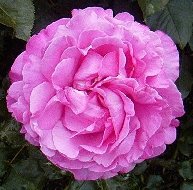
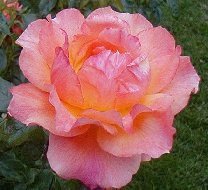 At about the same time traders and
plant hunters brought back new roses found during their travels,
particularly from the Orient, including the Chinas and the Teas,
which bloomed almost continuously (remontancy) in contrast to
the single bloom per season of the European varieties
At about the same time traders and
plant hunters brought back new roses found during their travels,
particularly from the Orient, including the Chinas and the Teas,
which bloomed almost continuously (remontancy) in contrast to
the single bloom per season of the European varieties

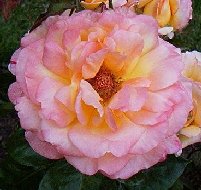 The French, who began breeding roses
around 1800 (with the support of Empress Josephine, who had established
an extensive collection of roses at Chateau de Malmaison outside
Paris after her divorce from Napoleon), quickly adopted these
new imports to produce the repeat-blooming hybrid Damask Perpetuals
and (on the Île Bourbon, now Réunion Island) the
Bourbon Rose
The French, who began breeding roses
around 1800 (with the support of Empress Josephine, who had established
an extensive collection of roses at Chateau de Malmaison outside
Paris after her divorce from Napoleon), quickly adopted these
new imports to produce the repeat-blooming hybrid Damask Perpetuals
and (on the Île Bourbon, now Réunion Island) the
Bourbon Rose
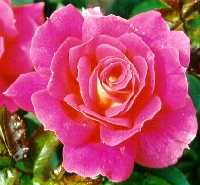
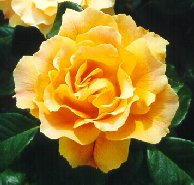
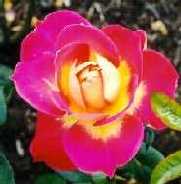 Modern roses include the Hybrid Teas,
a cross of Teas with Hybrid Perpetuals (first introduced in 1867),
still one of the most popular types (now with over 6,000 varieties),
and the Polyanthas ("many-flowered"; introduced ca.
1875) - derived from a Japanese R. multiflora; they are very hardy,
and continue to flower until the first frost
Modern roses include the Hybrid Teas,
a cross of Teas with Hybrid Perpetuals (first introduced in 1867),
still one of the most popular types (now with over 6,000 varieties),
and the Polyanthas ("many-flowered"; introduced ca.
1875) - derived from a Japanese R. multiflora; they are very hardy,
and continue to flower until the first frost
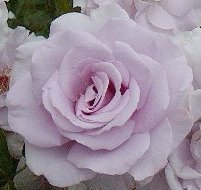
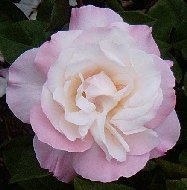
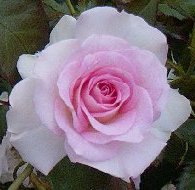 The Polyanthas were then crossed with
various Hybrid Teas, resulting in the Floribundas ("cluster-flowered";
introduced in 1939)
The Polyanthas were then crossed with
various Hybrid Teas, resulting in the Floribundas ("cluster-flowered";
introduced in 1939)
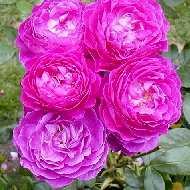
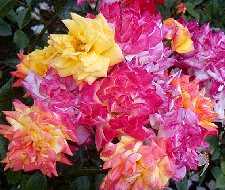
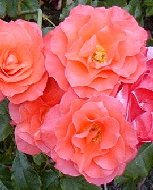 The first Grandiflora, the most recent
class of roses, was introduced in 1954; this group represents
a melding of Hybrid Tea and Floribunda characteristics, i.e.,
long stems for cuttings from the Hybrid Tea parent and prolific,
clustered blooms from the Floribunda side
The first Grandiflora, the most recent
class of roses, was introduced in 1954; this group represents
a melding of Hybrid Tea and Floribunda characteristics, i.e.,
long stems for cuttings from the Hybrid Tea parent and prolific,
clustered blooms from the Floribunda side

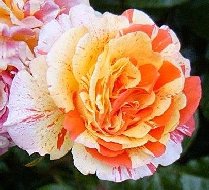 The flower pix below are from the sunken
rose gardens at Peninsula Park in north Portland, actually the
city's largest (17 acres, 8900 plants, 65 species) and oldest
(1909)
The flower pix below are from the sunken
rose gardens at Peninsula Park in north Portland, actually the
city's largest (17 acres, 8900 plants, 65 species) and oldest
(1909)
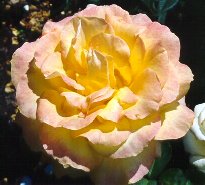
 Interesting link:
The American Rose Society | Return
to Home Page
Interesting link:
The American Rose Society | Return
to Home Page


































